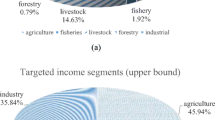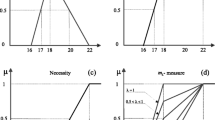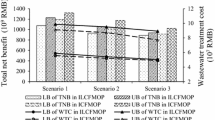Abstract
In this study, a two-stage fuzzy chance-constrained programming (TFCCP) approach is developed for water resources management under dual uncertainties. The concept of distribution with fuzzy probability (DFP) is presented as an extended form for expressing uncertainties. It is expressed as dual uncertainties with both stochastic and fuzzy characteristics. As an improvement upon the conventional inexact linear programming for handling uncertainties in the objective function and constraints, TFCCP has advantages in uncertainty reflection and policy analysis, especially when the input parameters are provided as fuzzy sets, probability distributions and DFPs. TFCCP integrates the two-stage stochastic programming (TSP) and fuzzy chance-constrained programming within a general optimization framework. TFCCP incorporates the pre-regulated water resources management policies directly into its optimization process to analyze various policy scenarios; each scenario has different economic penalty when the promised amounts are not delivered. TFCCP is applied to a water resources management system with three users. Solutions from TFCCP provide desired water allocation patterns, which maximize both the system’s benefits and feasibility. The results indicate that reasonable solutions were generated for objective function values and decision variables, thus a number of decision alternatives can be generated under different levels of stream flows, α-cut levels and fuzzy dominance indices.





Similar content being viewed by others
References
Ahmed S, Tawarmalani M, Sahinidis NV (2004) A finite branch-and-bound algorithm for two-stage stochastic integer programs. Math Program 100(2):355–377
Ben Abdelaziz F, Enneifar L, Martel JM (2004) A multiobjective fuzzy stochastic program for water resources optimization: the case of lake management. INFOR 42(3):201–215
Beraldi P, Grandinetti L, Musmanno R, Triki C (2000) Parallel algorithms to solve two-stage stochastic linear programs with robustness constrains. Parallel Comput 26:1889–1908
Chakraborty D (2002) Redefining chance-constrained programming in fuzzy environment. Fuzzy Sets Syst 125:327–333
Charnes A, Cooper WW (1983) Response to decision problems under risk and chance constrained programming: dilemmas in the transitions. Manage Sci 29:750–753
Charnes A, Cooper WW, Kirby P (1972) Chance constrained programming: an extension of statistical method. In: Optimizing methods in statistics. Academic Press, New York, pp 391–402
Cooper WW, Deng H, Huang Z, Li SX (2004) Chance constrained programming approaches to congestion in stochastic data envelopment analysis. Eur J Oper Res 155:487–501
Dai L, Chen CH, Birge JR (2000) Convergence properties of two-stage stochastic programming. J Optim Theory Appl 106:489–509
Dubois D, Prade H (1983) Ranking fuzzy numbers in the setting of possibility theory. Inf Sci 30:183–224
Guo P, Huang GH, He L (2007) ISMISIP: An inexact stochastic mixed integer linear semi-infinite programming approach for solid waste management and planning under uncertainty. Stoch Env Res Risk Assess doi:10.1007/s00477-007-0185-3
Hoppe H, Weilandt M, Orth H (2004) A combined water management approach based on river water quality standards. J Env Inf 3(2):67–76
Huang GH (1998) A hybrid inexact-stochastic water management model. Eur J Oper Res 107:137–158
Huang GH, Chang NB (2003) The perspectives of environmental informatics and systems analysis. J Env Inf 1:1–6
Huang GH, Loucks DP (2000) An inexact two-stage stochastic programming model for water resources management under uncertainty. Civil Eng Env Syst 17:95–118
Iskander MG (2002) Comparison of fuzzy numbers using possibility programming: comments and new concepts. Comput Math Appl 43:833–840
Iskander MG (2005) A suggested approach for possibility and necessity dominance indices in stochastic fuzzy linear programming. Appl Math Lett 18:395–399
Jung BS, Karnev BW Lambert MF (2006) Benchmark tests of evolutionary algorithms: mathematic evaluation and application to water distribution systems. J Env Inf 7(1):24–35
Li JB (2003) Integration of stochastic programming and factorial design for optimal reservoir operation. J Env Inf 1(2):12–17
Li YP, Huang GH, Nie SL (2006a) An interval-parameter multi-stage stochastic programming model for water resources management under uncertainty. Adv Water Resources 29:776–789
Li YP, Huang GH, Nie SL, Huang YF (2006b) IFTSIP: interval fuzzy two-stage stochastic mixed-integer linear programming: a case study for environmental management and planning. Civil Eng Env Syst 23(2):73–99
Loucks DP, Stedinger JR, Haith DA (1981) Water resource systems planning and analysis. PrenticeHall, Englewood Cliffs
Luo B, Maqsood I., Yin YY, Huang GH, Cohen SJ (2003) Adaption to climate change through water trading under uncertainty-An inexact two-stage nonlinear programming approach. J Env Inf 2:58–68
Maqsood I, Huang GH, Yeomans JS (2005) An interval-parameter fuzzy two-stage stochastic program for water resources management under uncertainty. Eur J Oper Res 167:208–225
Rangarajan S, Simonovic SP (1999) The value of considering autocorrelation between inflows in the stochastic planning of water resource systems. Water Resources Manage 13(6):427–442
Sethi LN, Panda SN, Nayak MK (2006) Optimal crop planning and water resources allocation in a coastal groundwater basin, Orissa, India. Agric Water Manage 83(3):209–220
Wang D, Adams BJ (1986) Optimization of real-time reservoir operations with Markov decision processes. Water Resources Res 22:345–352
Wu SM, Huang GH, Guo HC (1997) An interactive inexact-fuzzy approach for multiobjective planning of water resource systems. Water Sci Technol 36(5):235–242
Yin YY, Huang GH, Hipel KW (1999) Fuzzy relation analysis for multicriteria water resources management. J Water Resour Plan Manage ASCE 125(1):41–47
Acknowledgments
This research was supported by the Major State Basic Research Development Program (2005CB724200 and 2006CB403307) and the Natural Science and Engineering Research Council of Canada.
Author information
Authors and Affiliations
Corresponding author
Rights and permissions
About this article
Cite this article
Guo, P., Huang, G.H. Two-stage fuzzy chance-constrained programming: application to water resources management under dual uncertainties. Stoch Environ Res Risk Assess 23, 349–359 (2009). https://doi.org/10.1007/s00477-008-0221-y
Published:
Issue Date:
DOI: https://doi.org/10.1007/s00477-008-0221-y




